Tomato stem rot is another issue that tomato growers face aside from pests, leaf, and fruit problems. At a glance, it’s hard to determine what caused tomato stems to rot, especially with a ton of tomato plant diseases around.
The rapid spread of stem rot on tomatoes indicates a fungal disease infection. Sometimes, the stem rot comes from improper gardening practices like overhead watering and mountain mulching.
In this post, let us help you identify what causes tomato stem rot in your garden and how you can save your plants.
We’ll also share some best practices in tomato plant care and disease prevention so you can continue cultivating fresh tomatoes in your garden.
(You could use the table of contents below to jump to the sections that are most important to you.)
Q: What Causes Stem Rot on Tomatoes?
Tomato stem rot occurs due to too much watering and bacterial or fungal infection. Tomatoes and members of the nightshade family are sensitive to moisture because they are susceptible to several fungal diseases and pest infestations.
Bacterial disease in tomatoes often starts showing signs through stem rot. In most cases, tomato stem rot is a sign of severe fungal disease infection progression. Learn more about the difference, appearance, and treatment of bacterial and fungal diseases that cause tomato stem rot below.
11 Causes of Tomato Stem Rot [Symptoms & Treatments]
Here are the 11 possible causes of tomato stem rot and the treatment and prevention that you can do to save your plants and other crops in your garden:
#1 Overwatering/Poor Drainage
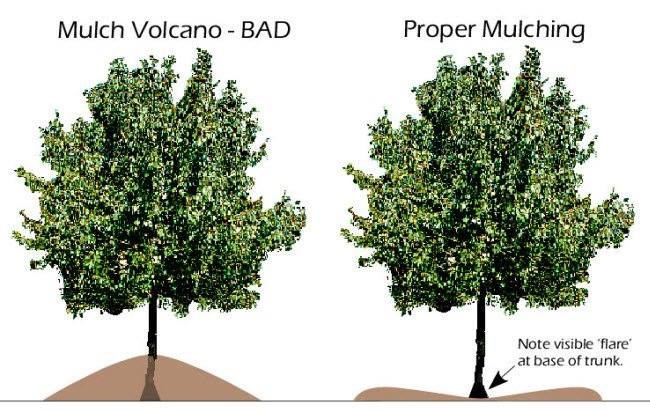
Not all tomato stem rot is due to a fungal or bacterial disease. So, if you’re panicking about having a plant pandemic, stop for a while and check the mulch. The stem rot may be due to the mountain or volcano mulching.
Symptoms: The rotting part is found in the part of the stem where mulch is attached.
Cause: Mountain mulching or volcano mulching is a practice where mulch is directly placed next to the stem. The mulch will absorb the water and retain them when you water your plants. The stagnant water in the mulch will cause stem rot.
If caught early, tomato plants can still recover from overwatering and mulching issues. However, once the spore of a fungal or bacterial disease gets into the rotten stem, the rotting may progress into a full-blown fungal or bacterial disease infection. By that time, your tomato plants may need a longer time to recover or even die.
Solution: Tomatoes don’t like wet feet. Remove the excess mulch at the bottom of the affected tomato plant and place a one to four-inch distance from the stem to the mulch.
Consider soil irrigation rather than foliar watering to prevent the water from staying too long on the leaves and stem. Water them on the drip line, where most of the roots are getting nutrients and moisture from the soil. The drip line is a few inches away from the stem.
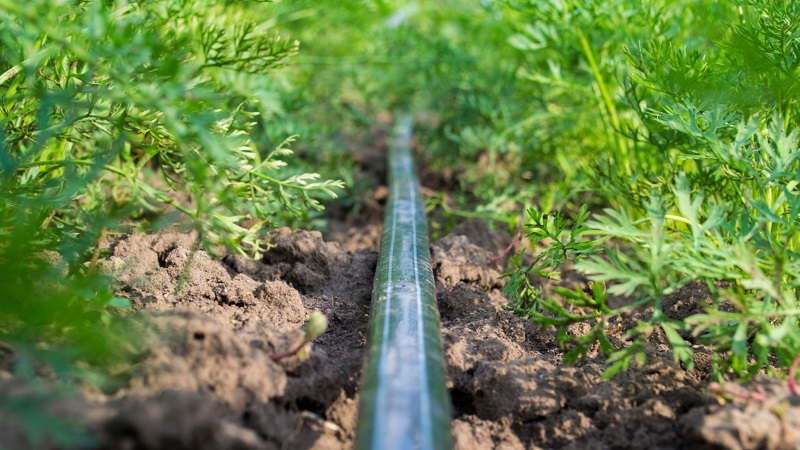
If you are growing several tomato plants, reduce the risk of overwatering by automating your watering routine using a drip irrigation system. Here are some home-friendly options that you can use:
#2 Tomato Pith Necrosis
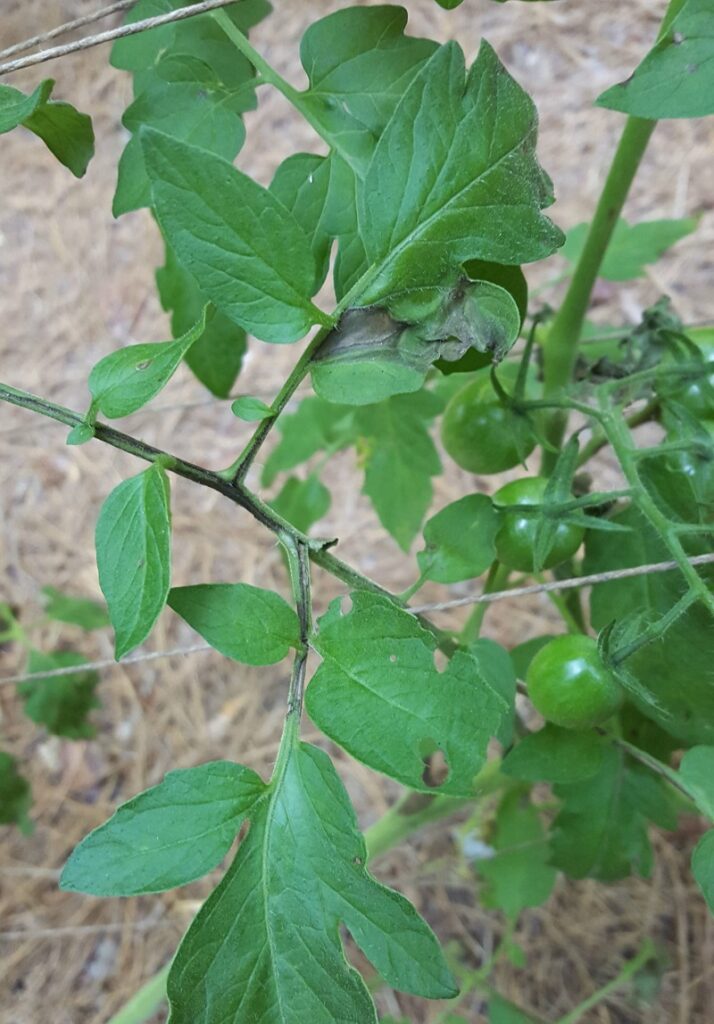
Source
Tomato pith necrosis is a fungal disease caused by the same group of soil-borne pathogens that causes bacterial soft rot in tomatoes. It is an early-season disease that attacks young tomatoes in small and high-tunnel greenhouses. The following pathogens spread in young tomatoes when it is cloudy or rainy:
- Pseudomonas corrugata
- Pectobacterium carotovorum
- Pseudomonas viridiflava
- Pseudomonas spp.
The disease starts when the bacteria enters the open wounds on the stem and roots of tomatoes.
Symptoms: Infected tomato plants have black lesions close to the leaf petioles or the thin structure that holds the leaves. Once the disease progresses, the leaves will also have black areas on their blades. The base of the stem becomes black but does not extend to the roots.
If left untreated, the necrosis-causing bacteria will invade the pith of the stem and cause small pockets until it becomes hollow.
In severe cases of tomato pith necrosis, the hollow stems crack open and split due to the lack of water supply. The leaves will also start to wilt and die.
Solution: The bacteria that causes tomato pith necrosis loves high humidity, partial light, and moist conditions. They also thrive in the presence of nitrogen in the soil and excessive watering.
The bacterial activity of pith neurosis usually subsides when the weather gets warmer, and the sun shines again. No fungicide or pesticide can treat this condition. You can only improve air circulation and watering to prevent creating a conducive environment for bacterial growth.
To prevent the future occurrence of necrotic pith, add more distance between your tomato plants for air circulation, maintain soil irrigation, and sterilize your garden tools on every use.
If your tomato plant dies due to tomato necrotic pith, remove the infected plant and place it in a bag to prevent spreading the disease.
You should also avoid planting tomatoes in the same spot for three years. Adding nitrogen to the soil also keeps the bacteria in the soil. In the meantime, you can opt for necrotic pith-resistant plants in the affected area.
#3 Bacterial Wilt
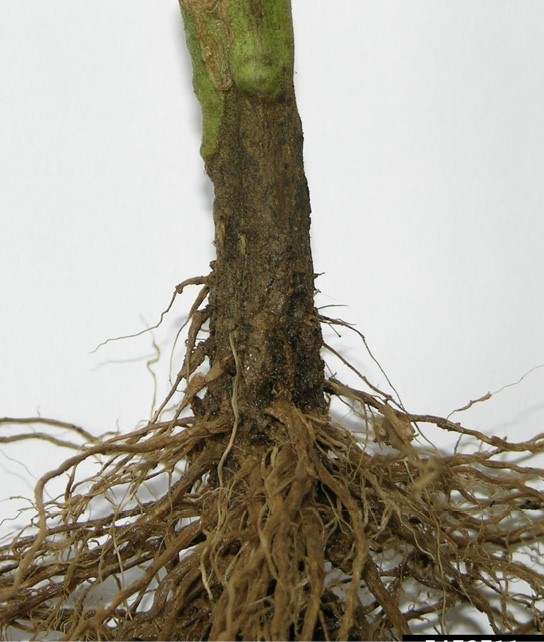
Photo by D. Ferrin, LSU AgCenter, Bugwood.org
Bacterial wilt, locally known as Southern bacterial blight, is a lethal disease that rapidly kills tomato plants. It is caused by the soil-borne bacteria Ralstonia solanacearum (Pseudomonas solanacearum) that attacks tomatoes during rainy days and in climates with extreme temperatures.
The bacterial wilt can be a primary condition of a sick tomato plant if the bacteria enters through its wounds during transplanting, pruning, or new root development. On the other hand, it can be a secondary condition after pest infestation damage.
Symptoms: In bacterial wilt cases, the tomato stem rot spreads rapidly throughout the plant and causes yellow oozing secretion inside the stem. The secretion will block the supply of water and nutrients throughout the plant.
The tomato leaves will remain green, but you notice that the plant is drooping. When the stems are cut, you will notice the rotting sides of the stem with slime oozing from it.
Solution: Plants infected with bacterial wilt are no longer viable for treatment. There are also no pesticides and fungicides that can treat bacterial-wilt-infected tomatoes. Remove the infected plants and seal them in a bag to prevent further contamination in your garden.
Avoid planting tomatoes and members of the nightshade family in the same plot for three years. You should also ensure that all gardening equipment and tools are clean and sterilized with bleach and dish soap after every use.
#4 Alternaria Stem Canker
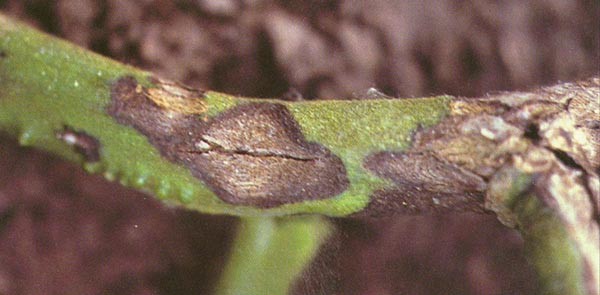
Source
Alternaria stem canker is probably the worst tomato fungal disease that causes tomato stem rot. It is caused by the fungus Alternaria alternata, which lives in the soil and indefinitely stays there. It infects a tomato plant when the spore from the soil gets to the stem or leaves through water splashes or unclean garden tools.
Symptoms: Susceptible tomato varieties to this disease may suffer dark lesions on the stem, leaves, and fruit. The lesions form concentric rings that grow and eventually kill the plant.
Solution: The only solution for Alternaria stem canker is planting resistant tomato varieties like Florida 47R, Phoenix, and Mariana. They remain in the soil, and tomato fungicides, even the chemical ones, can’t treat them. Crop rotation will also not work for this disease.
Drip irrigation and routine preventive fungicide sprays are recommended for susceptible tomato varieties.
#5 Bacterial Canker in Tomatoes
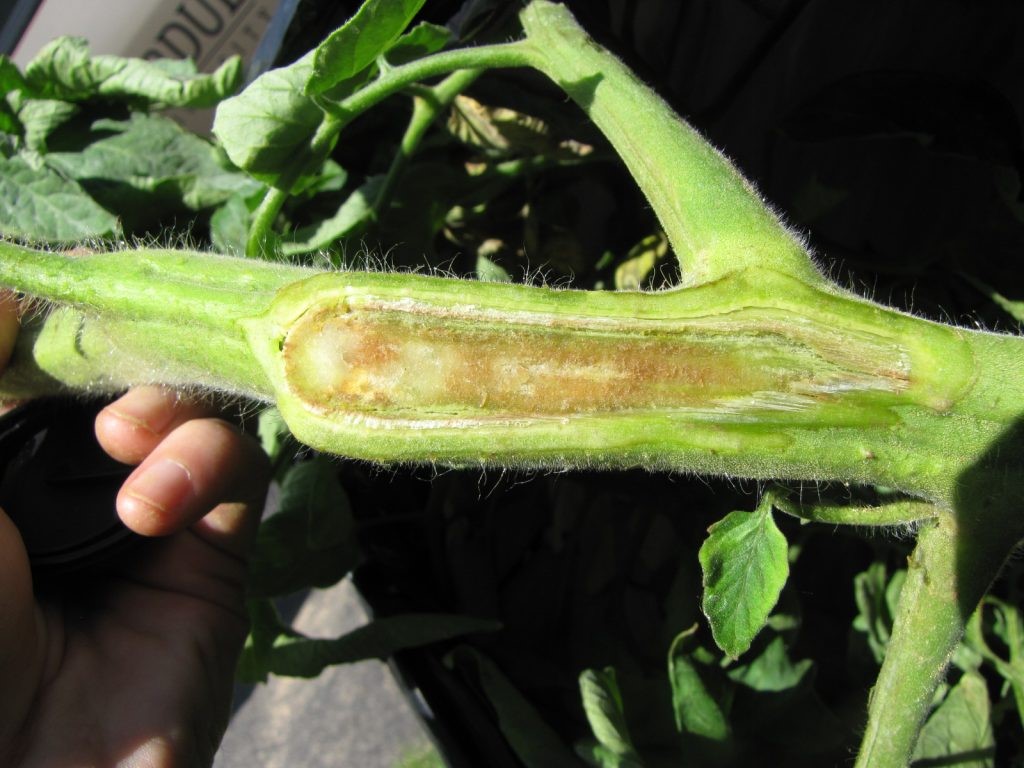
Bacterial canker is a disease that occurs in tomatoes through pathogen-infected seeds and transplants. It is caused by the bacterium Clavibacter Michiganensis, which is known for being seed-borne and stays in weeds and decaying plant tissues.
Symptoms: Bacterial canker causes black spots on the stem of tomatoes. There is also a yellow oozing slime that comes out of the affected stem when pinched. In some cases, the stems split that create long dark cankers.
Aside from the stem, the progression of the disease also affects the tomato leaves and fruits. Leaves develop black lesions, and the tomato fruits have white spots.
Solution: There are physical and chemical methods to treat and prevent bacterial canker on tomatoes. First is the heat treatment of tomato seeds by soaking them in hot water at 122 F temperature for 25 minutes.
Another way is to remove any weeds or decaying matter around your tomatoes to prevent any conducive environment where the bacteria can stay.
For chemical treatments, you may use fungicides with cymoxanil and famoxadone. For starters, you can try using Katyayani CYMOXANIL 8% for early treatment of bacterial canker on tomatoes.
#6 Collar Rot
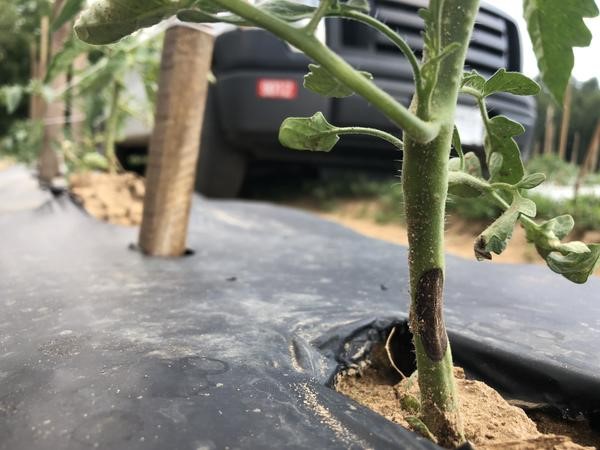
Collar rot is often mistaken as Alternaria stem canker due to their almost similar symptoms. It is an early-season disease caused by Alternaria linariae, the same culprit for early blight in tomatoes.
Collar rot is the early phase or early blight where the infection starts from the infected stem of seedling tomatoes.
Symptoms: Affected tomato plants have small, dark, and sunken lesions on the stem. The lesions enlarge, forming larger rings with a light-colored center. The bacteria will spread rapidly throughout the plant that can cause its death.
Treatments: There is no treatment for collar rot, and if the plant survives it may be difficult to help it produce fruits. There are also resistant varieties to collar rot, but you can choose tomato varieties resistant to early blight.
Performing crop rotation every three years can help reduce the fungus population in the soil. You must also maintain preventive pesticide and fungicide sprays to keep collar rot at bay.
#7 Severe Early Blight
Early blight is also caused by the bacterium involved in collar rot. The severe phase of early blight also causes tomato stem rot but with larger sunken lesions.
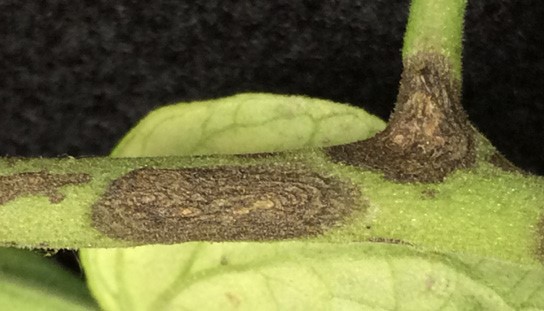
Photo by R. A. Melanson, MSU Extension, Bugwood.org
Symptoms: Stem rot due to severe early blight are found on any part of the stem. The lessons are black, dry, and sunken. The lesions inhibit the proper distribution of water and nutrients throughout the plant, which weakens the plants and causes them to die.
Solutions: In most cases, treating tomatoes in the most severe case of early blight is a lost cause. However, if caught early you can use the following fungicides to save your crops.
- Bonide 775 Copper Fungicide Rtu
- Safer Brand Garden Fungicide Ready to Use
- Bonide Mancozeb Flowable w/ Zinc Concentrate
In cases where the plants succumb to early blight, perform crop rotation within a three-year interval. Ensure that your gardening tools and equipment are sanitized before and after use.
#8 Didymella Stem Rot
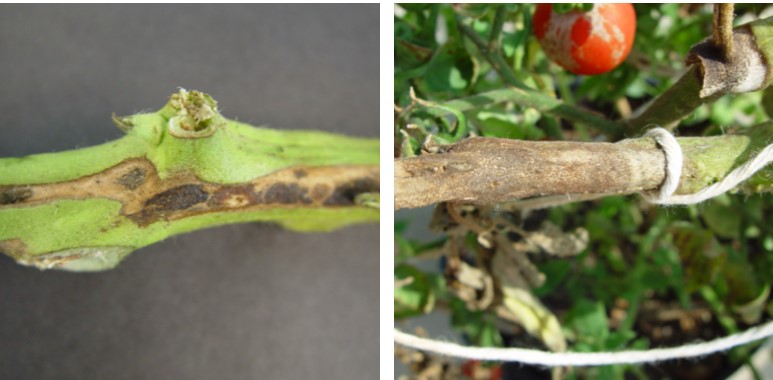
Source
Didymella stem rot is a fungal disease caused by Didymella lycopersici (Phoma lycopersici). It affects tomatoes through its spores spread through water splashes and unsanitized gardening tools. The fungus stays in the soil but reduces in number during crop rotation.
Symptoms: The black lesions start at the base of the stem and spread throughout the plant. The lesion girdles the stem, which causes the disruption of moisture and nutrient distribution to other plant parts. Black specks or the fruiting bodies of the fungus will form on the black lesions that produce another batch of spores.
Solutions: Fungicide spray like Benomyl can efficiently treat Didymella-infected tomatoes. For prevention, make sure to have a three-year crop rotation, regular weeding and cleanup, and sanitation of gardening tools to keep the Didymella fungus spores from spreading.
#9 Timber Rot or Sclerotinia Stem Rot (White Mold Disease)
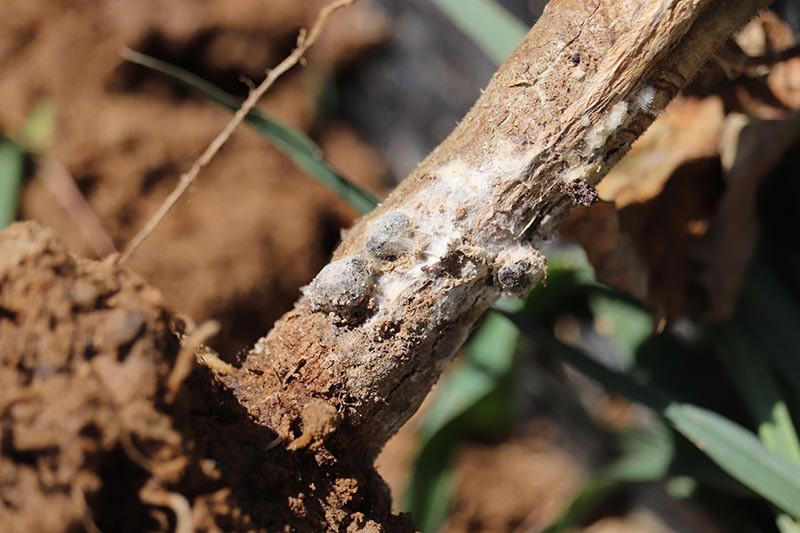
Source: Rebecca Melanson
Timber rot is a stem rot disease prevalent in high humidity and cold weather conditions. It is caused by the fungus Sclerotinia sclerotiorum that comes from a wide range of vegetable plant hosts, including certain types of weeds like:
- Lambsquarters
- Pigweed
- Canada thistle
- Wild mustard
The infection usually starts in the soaked stem joints of tomatoes due to overhead or foliar watering. Timber rot often occurs in the early development of tomato plants, right before they start flowering.
Symptoms: Timber rot manifests as a cottony white mold that forms on the stem joints of tomatoes. The white substance is the mycelium of the fungus.
As the disease becomes severe, the fungus creates a grain-like food reserve called sclerotia that are attached to the lesions. The infected part will soon become dry and collapse, causing the plant to die.
Solution: Due to the number of susceptible hosts for timber rot, fungicide sprays and crop rotations are not the ideal options to reduce the sclerotia in the soil. There is also no resistant tomato variety to timber rot.
Though careful removal of infected plants might work, it does not guarantee that there will be no occurrence of timber rot next year. You may use a biological fungicide called Contans® that contains the beneficial fungus Coniothyrium minitans that feed on the sclerotia in the soil.
#10 Fusarium Crown Rot
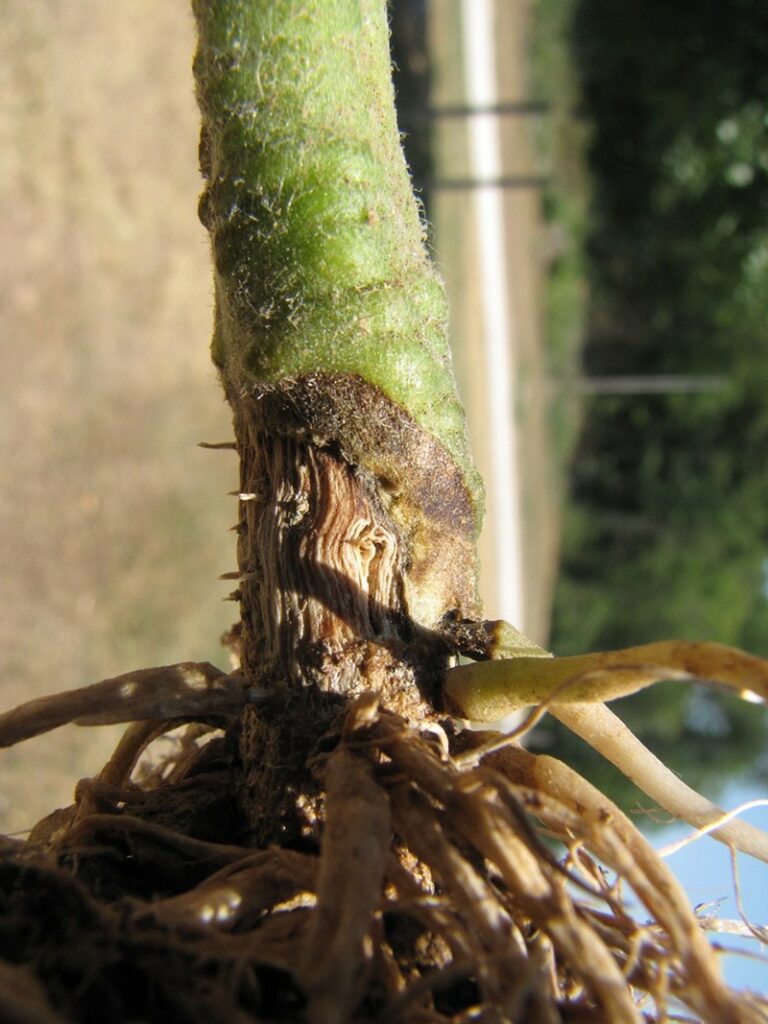
Source
Fusarium crown rot is a fungal disease caused by Fusarium oxysporum f.sp. Radicis-lycopersici that stays in the soil without a host. It often occurs in greenhouses and high-tunnel greenhouses during cool and rainy weather.
Symptoms: Fusarium crown rot often starts from the roots up to the stem. The stem has brown or black lesions that look like something bit it from the ground. The lesions girdle the stem. If the lesion moves upwards, it is an indication that it is a Fusarium wilt.
Solutions: The most viable solution for Fusarium crown rot is to plant your tomatoes in pots. No fungicide can control fusarium crown rot, especially in severe cases. Crown rotation may work but is not applicable for commercially-grown tomatoes. There are also no known resistant tomato varieties to Fusarium crown rot.
#11 Tomato Stem Rot Due To Botrytis Gray Mold
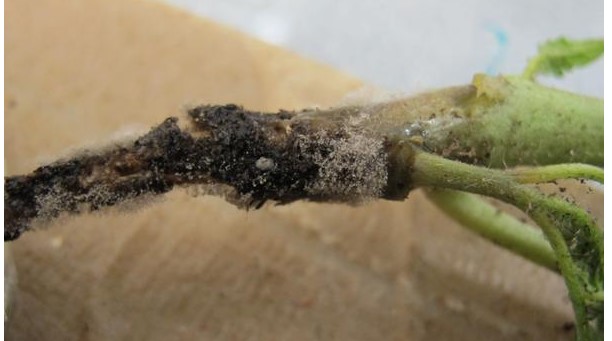
Source: Shawn Butler, NCSU PDIC
Botrytis gray mold is another notorious fungal disease in tomatoes that affects the stems, leaves, and fruits. It is caused by the fungus Botrytis cinerea (B. cinerea). It affects plants through its pathogens and saprophytes, which attack the plant from its leaves down to its roots.
Symptoms: Stem infection starts through the wounds caused by pruning, leaf scars, and plant damage due to pests. The fungus is dormant in the plant scars for 12 weeks and becomes active when the plant is stressed.
The lesions on the stem will develop a grayish mold-like color that releases a puff of fungus spores. As the disease progresses, the upper part of the infected stem will dry out and die.
Solutions: Severely infected tomatoes are no longer viable for treatment. No known tomato variety is resistant to Botrytis. For early detection, fungicides with chlorothalonil may still save the plant.
For preventive control of Botry crown rot, maintain a temperature of 70°F to discourage Botrytis-causing spores around. You should also avoid overhead irrigation and keep a routine fungicide spray throughout the growing season.
Frequently Asked Questions (FAQs)
Can tomato plants recover from stem rot?
Yes, with overwatering issues and early detection of some fungal diseases, tomato plants can still recover. However, infections caused by severe bacterial plant diseases can make your tomato plants no longer viable for treatment.
How do you prevent tomato stem rot?
Prevent stem rot by keeping a 1 -3 inch distance between the stem and the mulch. You must also avoid overhead watering, sanitize your gardening tools, and maintain a routine fungicide spray until harvest season.
On top of it all, keep your tomatoes healthy and vigorous, plant stress attracts pests and fungal diseases and can cause severe crop loss.
Can I reverse stem rot?
Early-stage and small stem rot can still be reversed, especially with tomato stem rot caused by overwatering issues and some mild fungal diseases. However, bacterial canker and other lethal plant diseases often lead to crop loss.
Final Thoughts
We hope that this comprehensive guide helped find the culprit behind the tomato stem rot on your plants. It may not be easy to identify them at first, but with experience and a little research, you’ll soon pinpoint the problem.
Tomatoes are quite sensitive plants and need a lot of care. With proper sanitation, routine fungal disease treatment, and proper variety selection, you can surely win against plant pests and disease.
Let us know in the comment section what caused the stem rot on your tomatoes and your experience in controlling it. If you want to learn more about tomato plant care, check out our posts here and start becoming a pro!
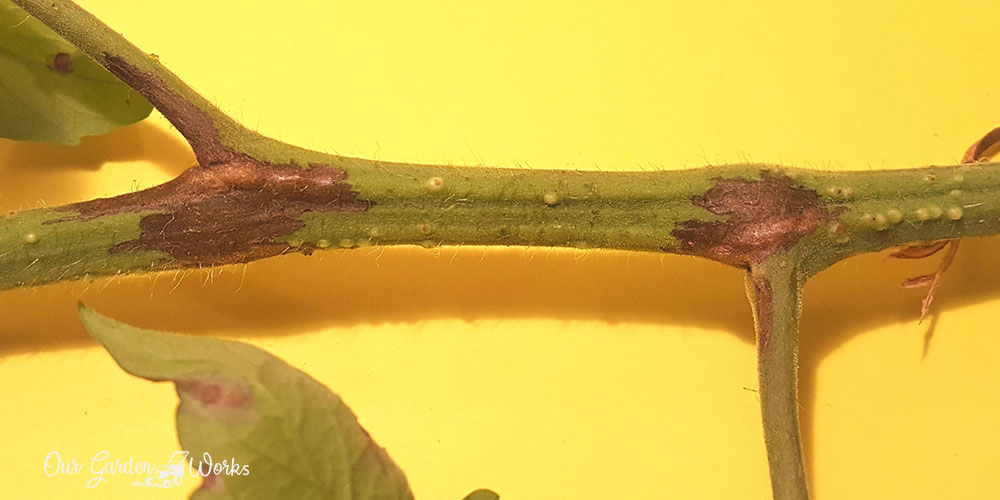
thanks for the above information l thought l knew how to farm tomatoes
l had a small garden doing well but with this information l should start to
read more on tomatoes
thanks again